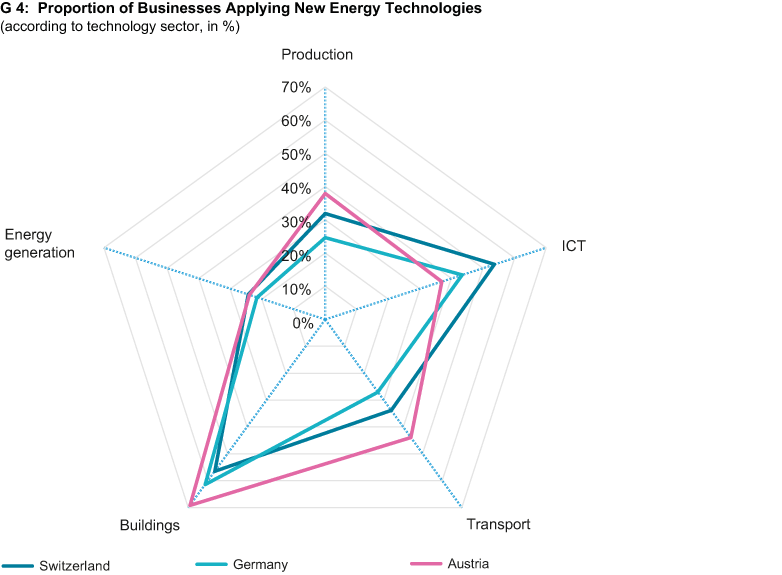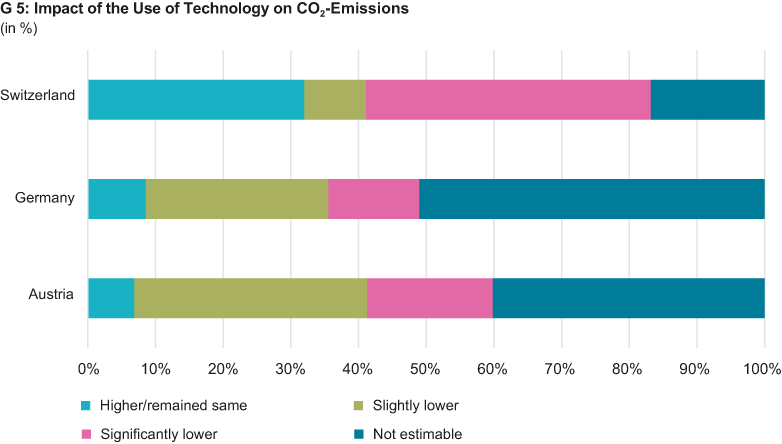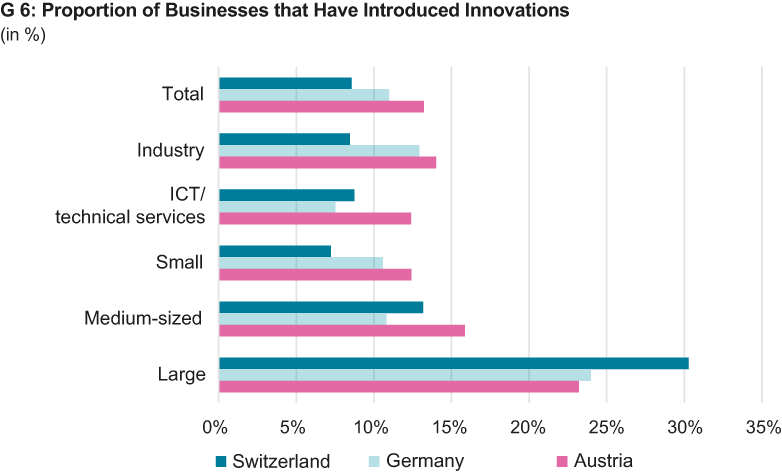New Energy Technologies in Swiss Businesses
- Innovation
- KOF Bulletin
- Energy
Why businesses develop and implement new technologies – or why they don't: this question has been considered by an international team of researchers as part of the national research programme “Managing Energy Consumption”.

One of the main goals of the Federal Council’s “Energy Strategy 2050” is to use the existing potential of energy efficiency, most of which potential depends upon the development of new technologies and their dissemination throughout the economy. There is not always an economic incentive to develop such technologies for other businesses or to implement them within one’s own business. The uncertainty surrounding technical success is often too high, as are the costs of developing these technologies; alternatively, businesses may not be willing to make the necessary investments or the amortisation period for the technology may be too long. It is not least for this reason that energy policy measures are necessary in order to increase the use of environmentally friendly technologies.
Working in conjunction with the Austrian Institute for Economic Research (Institut für Wirtschaftsforschung, WIFO) in Vienna and the Centre for European Economic Research (Zentrum für Europäische Wirtschaftsforschung, ZEW) in Mannheim, and with financial support from the Swiss National Fund as part of the national research programme “Managing Energy Consumption” (NRP 71), the KOF has been able to analyse and compare implementation patterns and technological activities or effective policies in Germany, Austria and Switzerland.
Different rates of introduction
25 per cent of Swiss businesses introduced energy technologies between 2012 and 2014. We have defined these as energy saving technologies and technologies for exploiting renewable sources of energy (e.g. solar, wind and water power). These technologies were largely sourced externally and were not developed by businesses themselves. The corresponding rates of introduction were higher in Austria (32 per cent) and Germany (40 per cent). These differences may be attributed both to the economic policy environment as well as to differing launch dates. For instance, Swiss firms may already have introduced energy technologies on a significant scale prior to 2012 – consequently, the demand for these technologies during the period covered by the investigation would be lower.
Energy-efficient technologies mainly in the building sector
It is thus more informative to ask in which areas energy technologies are being introduced and whether CO2 emissions can thereby be reduced. Based on the firms that have introduced these technologies, a strong focus on building technologies is apparent (see G 4): between 56 per cent (Switzerland) and 69 per cent (Germany) of businesses have introduced energy technologies in this area, followed by information and communications technologies, transport-related technologies, production technologies and renewable energy generation technologies. The focus on the building sector reflects the fact that it has the greatest potential for savings.
Reduced emissions for around one half of companies
The achievement of emissions targets is high up on the environmental agenda of a number of countries, including Switzerland. The introduction of energy-efficient technologies may contribute to achieving these targets; 53 per cent of firms in Austria, 51 per cent of firms in Switzerland and 40 per cent of firms in Germany have reported a fall in CO2 emissions per unit/per process (see G 5) as a result of the introduction of new energy technology. Although a so-called “rebound effect”, i.e. overall higher CO2 emissions due to an increase in unit numbers, cannot be excluded, this is unlikely given the current moderate rates of growth in the countries observed. In addition, the 42 per cent of Swiss firms that have introduced energy technologies report significantly reduced emissions. When interpreting G 5 it must be remembered that, compared to Swiss companies, far more Austrian and in particular German companies have been unable to assess the implications of the use of such technologies.
Energy technologies are too expensive
The high cost of new energy technologies is a significant obstacle to their introduction or more intensive usage. Further important aspects include long amortisation periods and the limited scope for action, due for instance to the fact that a firm may only be able to make limited structural changes because it is a tenant. It is noteworthy that Swiss companies are more likely to indicate a lack of financial resources and staff as a relevant obstacle than firms from the other two countries. A lack of political framework conditions is mentioned as an obstacle in particular by Austrian companies.
Some firms are developing new energy technologies
Energy technologies need to be developed in order for them to be implemented within a business. The results of the survey show that overall between nine and 13 per cent of firms developed and marketed new energy technologies during the period under observation (2012 to 2014; see G 6). However, the characteristics of the firms that developed technologies differed between the three countries. It is striking that, at 30 per cent, in Switzerland the proportion of large firms (more than 250 employees) marketing energy technologies is significantly higher than in the other two countries. This may be due to the different industrial structure in the other two countries or to the overall relatively highly developed system for promoting innovation in Germany and Austria, which is focused mainly on small and medium-sized enterprises.
Costs also play a major role in development
The aim of governments is often to maintain or enhance innovation in the sector through energy policy measures. The identification of obstacles for businesses can provide an important input into this process. The most significant obstacles in relation to the development of new energy technologies in Switzerland include: the fact that the product of the business concerned is not amenable to energy technology innovation, unwillingness of customers to pay for such innovation, high development costs and a lack of management capacity, which is often committed elsewhere. It is apparent in this respect that cost aspects play a major role also in the development of energy technologies: on the one hand, the descriptive results concerning the introduction of energy technologies show that they are often considered to be too expensive, whilst on the other hand the developers of energy technologies complain of excessively high development costs and an unwillingness of customers to pay extra.
Information
The results of the project are based on a written survey of a representative sample of 5,789 Swiss, 6,374 German and 7,091 Austrian firms. The samples from the three countries were stratified according to company size and sector. The response rate was 31.4 per cent in Switzerland, 36.4 per cent in Germany and 7.6 per cent in Austria. The surveys were carried out at the same time in all three countries and on the basis of a uniform questionnaire.
Further information may be found in KOF Study No. 77 «Creation and Adoption of Energy-related Innovation – the Main Facts»
Contact
KOF Konjunkturforschungsstelle
Leonhardstrasse 21
8092
Zürich
Switzerland



